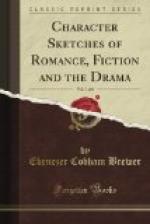DAR’-THULA, daughter of Colla, and “fairest of Erin’s maidens.” She fell in love with Nathos, one of the three sons of Usnoth, lord of Etha (in Argyllshire). Cairbar, the rebel was also in love with her, but his suit was rejected. Nathos was made commander of King Cormac’s army at the death of Cuthullin, and for a time upheld the tottering throne. But the rebel grew stronger and stronger, and at length found means to murder the young king; whereupon the army under Nathos deserted. Nathos was now obliged to quit Ireland, and Dar-Thula fled with him. A storm drove the vessel back to Ulster, where Cairbar was encamped, and Nathos, with his two brothers, being overpowered by numbers, fell. Dar-Thula was arrayed as a young warrior; but when her lover was slain “her shield fell from her arm; her breast of snow appeared, but it was stained with blood. An arrow was fixed in her side,” and her dying blood was mingled with that of the three brothers.—Ossian, Dar-Thula (founded on the story of “Deirdri,” i. Trans, of the Gaelic Soc.)
DAR’TLE (Rosa), companion of Mrs. Steerforth. She loved Mrs. Steerforth’s son, but her love was not reciprocated. Miss Dartle is a vindictive woman, noted for a scar on her lip, which told tales when her temper was aroused. This scar was from a wound given by young Steerforth, who struck her on the lip when a boy.—C. Dickens, David Copperfield (1849).
DARWIN’S MISSING LINK, the link between the monkey and man. According to Darwin, the present host of animal life began from a few elemental forms, which developed, and by natural selection propagated certain types of animals, while others less suited to the battle of life died out. Thus, beginning with the larvae of ascidians (a marine mollusc,) we get by development to fish lowly organized (as the lancelet), thence to ganoids and other fish, then to amphibians. From amphibians we get to birds and reptiles, and thence to mammals, among which comes the monkey, between which and man is a MISSING LINK.
DASHALL (The Hon. Tom), cousin of Tally-ho. The rambles and adventures of these two blades are related by Pierce Egan (1821-1822).
D’ASUMAR (Count), an old Nestor who fancied nothing was so good as when he was a young man.
“Alas! I see no men nowadays comparable to those I knew heretofore; and the tournaments are not performed with half the magnificence as when I was a young man....” Seeing some fine peaches served up, he observed, “In my time, the peaches were much larger than they are at present; natures degenerates every day.” “At that rate,” said his companion, smiling, “the peaches of Adam’s time must have been wonderfully large.”—Lesage, Gil Blas, iv. 7 (1724).
DAUGHTER (The), a drama by S. Knowles (1836). Marian, “daughter” of Robert, once a wrecker, was betrothed to Edward, a sailor, who went on his last voyage, and intended then to marry her. During




